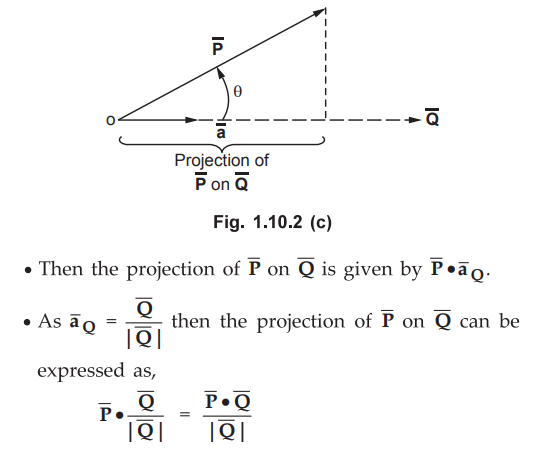Electromagnetic Theory: Unit I: (a) Vector Analysis
Scalar or Dot Product of Vectors
Properties, Applications, Solved Example Problems
The result of such a dot product is scalar hence it is also called scalar product.
Scalar or
Dot Product of Vectors
AU : May-06, Dec.-09
•
The scalar or dot of the two vectors  is denoted as
is denoted as and
defined as the product of the magnitude of A, the magnitude of B and the cosine
of the smaller angle between them.
and
defined as the product of the magnitude of A, the magnitude of B and the cosine
of the smaller angle between them.
•
It also can be defined as the product of magnitude of ![]() and the projection
of
and the projection
of ![]() onto
onto ![]() or viceversa.
or viceversa.
•
Mathematically it is expressed as,
 ... (1.10.1)
... (1.10.1)
•
The result of such a dot product is scalar
hence it is also called scalar
product.

1. Properties of Dot Product
•
The various properties of the dot product are,
1.
If the two vectors are parallel to each other i.e. θ = 0° then cos θAB
= 1 thus
 for parallel vectors ... (1.10.2)
for parallel vectors ... (1.10.2)
2.
If the two vectors are perpendicular to each other i.e. θ = 90° then cos θAB
= 0 thus
 = 0 for perpendicular vectors ...
(1.10.3)
= 0 for perpendicular vectors ...
(1.10.3)
•
In other words, if dot product of the two vectors is zero, the two vectors are
perpendicular to each other.
3.
The dot product obeys commutative law,
 ...(1.10.4)
...(1.10.4)
4.
The dot product obeys distributive law,
 ...(1.10.5)
...(1.10.5)
5.
If the dot product of vector with itself is performed, the result is square of
the magnitude of that vector.
 ...(1.10.6)
...(1.10.6)
6.
Consider the unit vectors  in cartesian co-ordinate system. All
these vectors are mutually perpendicular
to each other. Hence the dot product of different unit vectors is zero.
in cartesian co-ordinate system. All
these vectors are mutually perpendicular
to each other. Hence the dot product of different unit vectors is zero.
 ...
(1.10.7)
...
(1.10.7)
7.
Any unit vector dotted with itself is unity,
 ...
(1.10.8)
...
(1.10.8)
8.
Consider two vectors in cartesian co-ordinate system,

•
This product has nine scalar terms as dot product obeys distributive law. But
from the equation (1.10.7), six terms out of nine will be zero involving the
dot products of different unit vectors. While the remaining three terms involve
the unit vector dotted with itself, the result of which is unity.
 ...
(1.10.9)
...
(1.10.9)
2. Applications of Dot Product
The
applications of dot product are,
1. To determine the angle between
the two vectors.
The
angle can be determined as,

2. To find the component of a
vector in a given direction.
•
Consider a vector  as shown in the Fig. 1.10.2 (a).
The component of vector
as shown in the Fig. 1.10.2 (a).
The component of vector ![]() in the direction of unit vector a is
in the direction of unit vector a is  . This is a scalar quantity.
This is shown in the Fig. 1.10.2 (a).
. This is a scalar quantity.
This is shown in the Fig. 1.10.2 (a).
p
•
The sign of this component is positive if 0 ≤ θ < 90o while the
sign of this component is negative if 90o < θ ≤180o .
If the component vector of p ![]() in the direction of unit vector
in the direction of unit vector ![]() is required then multiply the component
obtained by that unit vector, as shown in the Fig. 1.10.2 (b). Thus
is required then multiply the component
obtained by that unit vector, as shown in the Fig. 1.10.2 (b). Thus  is the component vector of
is the component vector of 


•
This is the geometrical meaning of dot product, to find projection of ![]() in the direction of unit vector
in the direction of unit vector![]()
•
If the projection of![]() on other vector
on other vector ![]() is to be obtained
then it is necessary to find unit vector in the direction of
is to be obtained
then it is necessary to find unit vector in the direction of 

3 Physically, work done by a
constant force can be expressed as a dot product of two vectors.
•
Consider a constant force ![]() acting on a body and it causes the
displacement
acting on a body and it causes the
displacement ![]() of that body. Then the work done W is the product of the
force and the component of the displacement in the direction of force which can
be expressed as,
of that body. Then the work done W is the product of the
force and the component of the displacement in the direction of force which can
be expressed as,

•
But if the force applied varies along the path then the total work done is to
be calculated by the integration of a dot product as,


Examples for Practice

Review Question
1. Define dot product
of vectors. State its applications.
Electromagnetic Theory: Unit I: (a) Vector Analysis : Tag: : Properties, Applications, Solved Example Problems - Scalar or Dot Product of Vectors
Related Topics
Related Subjects
Electromagnetic Theory
EE3301 3rd Semester EEE Dept | 2021 Regulation | 3rd Semester EEE Dept 2021 Regulation
